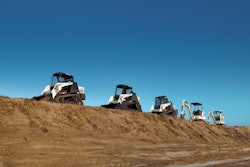The Association of Equipment Management Professionals kicked off it’s 2012 Asset Management Symposium and Professional Development Institute this morning in Louisville, Kentucky, with a half-day look at the opportunities and challenges that telematics offer to yellow iron fleet managers
Bill Sauber, of Volvo Construction Equipment gave the first presentation with a practical and not often discussed explanation of the difference between telematics and GPS.
Telematics, he defined, is the technology of wirelessly transmitting computerized data to the internet using onboard ECUs and ECMs. Telematics uses GPS, but GPS gives information on location only, no other data
GPS uses GPS satellites in orbit 12,550 miles above the earth. Telematics uses communication satellites 248 miles up. GPS satellites orbit every 12 hours, telematics satellites orbit every 90 minutes. GPS uses three to six satellites at one time. Telematics uses one to two satellites at a time. GPS uses triangulation uses atomic clocks. Telematics communicates via cell phone, wifi, and gets only its location information from GPS.
Jeff Akers, a telematics consultant with 25 years of experience in developing and selling technology companies and services talked about the transformation of business in the age of data. He noted that in the next five years more than 150 million square feet of floor space in data centers will be built around the world to handle this tsunami of information that is coming, and he talked of the world of data-based information as a matrix, almost like the movie of the same name.
The next big change Akers says is to realize that your business is becoming part of this matrix and to take the information and use it to look at your business in a different way. “Display it in a way that people who don’t know your business can understand how you drive efficiency,” he said. ” Use it to get feedback from project managers. I’m here to tell you with all the stuff you are working on you can see the entire operation every Monday morning. Bottom line, you are all involved in a completely new way of doing business.”
It’s a given that telematics can save a construction company 7 to 10 percent of it’s asset costs and improve operational efficiency, Akers said. Fleet managers who recognize this, embrace it and use it to drive change are going to be elevated in importance and visibility within their organizations. This is because a successful telematics program reaches into so many other aspects of a company’s business–finance, operations, IT, and strategic planning.












